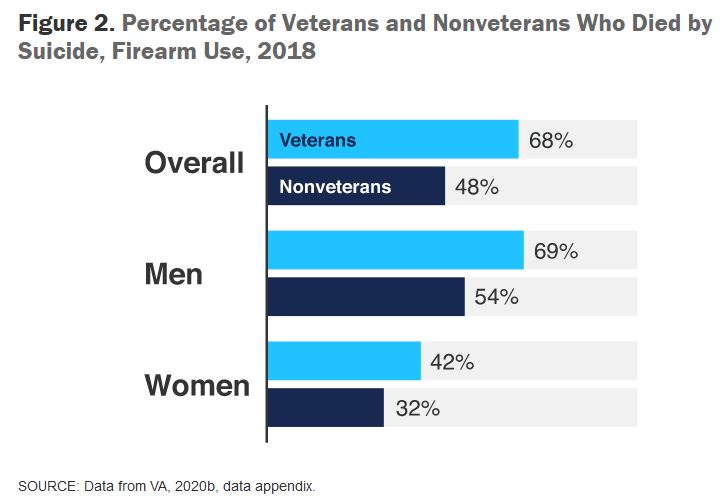TAMPA, FL — Most, 70%, of suicides among U.S. veterans are due to firearm injury. Yet, according to a new study, not enough veterans are taking advantage of the opportunity to discuss firearm safety with their healthcare providers.
Why is that an issue? Because discussing firearm access has been found to be an important part of evidence-based suicide prevention programs. Reducing access to commonly used and highly lethal methods of suicide has been shown to lower suicide rates.
A recent study in Suicide and Life-Threatening Behavior analyzed results from a 2019 national online survey of U.S. adults living in households with firearms, which had a 65% response rate. The study aimed to quantify the percentage of veterans who have discussed firearm safety with healthcare providers.1
The participants included nearly 700 self-identified veteran firearm owners who were asked, “Has a physician or other healthcare practitioner ever spoken to you about firearm safety?” The survey was designed and weighted to reflect the perspectives of a nationally representative sample of veteran firearm owners. The results were stratified based on self-reported use of Veterans Health Administration (VHA) healthcare services.
The study found a large majority of veteran firearm owners haven’t had a firearm safety discussion with a clinician or don’t recall having this type of conversation, which suggests additional efforts to facilitate these discussions in the VHA and other healthcare facilities are needed.
“Only 9.2% of U.S. veterans report ever having had a discussion with a clinician about firearm safety; far lower than what is likely indicated,” lead study author Joseph Simonetti, MD, MPH, a clinical investigator at the Rocky Mountain Mental Illness Research, Education and Clinical Center for Suicide Prevention at the Aurora, CO, Rocky Mountain Regional VAMC, told U.S. Medicine. “This was somewhat higher among veterans who reported recently using Veterans Health Administration services (14.3%). Whether this difference is attributable to VHA’s efforts to expand suicide prevention services is unknown.”
Veterans and non-veterans are susceptible to suicide risk factors such as mental illness, substance-related conditions, declines in physical health and social and economic stressors. However, veterans are affected by additional suicide risk factors because of their military service, including post-traumatic stress disorder (PTSD) related to military traumas (e.g., physical injury and moral injury), military sexual trauma and stressors in life transitions, Simonetti, who also is an assistant professor of medicine at the University of Colorado School of Medicine, explained in an email.
The study’s results demonstrated that some progress has been made in providing firearm counseling to at-risk veterans, but there’s still more work to do.
“They also highlight the critical role that outpatient primary and specialty care settings have in delivering suicide prevention services to patients, in that more than two-thirds of those who reported receiving counseling said that they received it in those locations rather than, for example, outpatient mental health settings,” Simonetti wrote. “Even though most veterans receive their healthcare outside of the VHA system, less than 5% said they received counseling with an outpatient mental health clinician outside of the VHA system.”
He noted that the study occurred within the first couple of years of VHA’s efforts to expand suicide risk identification and firearm suicide prevention efforts within its clinical settings. The percentage of U.S. veterans who have spoken with a clinician about firearm safety is likely an underestimate in comparison to what veteran firearm owners might say if this study were conducted today, he explained.
Though the majority of suicides among U.S. veterans are due to firearm injury, physicians or other healthcare practitioners might not speak to veterans about firearm safety because it’s outside their area of expertise, he suggested.
“Discussing firearm suicide prevention with patients requires a unique skill set, and that skill set has not typically been included in the training of U.S. clinicians, although there are some exceptions,” Simonetti noted. “Some clinicians have voiced concerns that they may upset their patients if they ask about firearms. However, our other studies have clearly shown that discussing firearm injury prevention during clinical encounters, particularly when someone is at risk of suicide, is broadly acceptable, including among firearm owners. There is also a lingering misconception that certain laws or policies prohibit clinicians from asking about firearms during clinical encounters. This is not the case. There are currently no prohibitions that impact whether clinicians can ask and counsel about firearms when they are concerned that their patients or family members are at risk of injury.”
A May 2022 Prevention Medicine study found that 83% of U.S. adults who resided in households with firearms agreed that firearm safety counseling should at least sometimes be a part of routine clinical care when a patient or their family member is at risk of suicide, Simonetti explained.2
Encouraging veterans to reduce their access to firearms when they are at risk of suicide is an essential element of evidence-based suicide prevention practice. Limiting access to firearms is one proven strategy to reduce suicide, but it’s still unclear how clinicians can best assist veterans in making those decisions.
When physicians or other healthcare practitioners are speaking with veterans about firearm safety, conversations typically include assessing the veteran’s suicide risk, their access to firearms and firearm storage practices; understanding why they keep firearms and store them the way they do; and evaluating their motivations and obstacles for potentially reducing their access, even temporarily, Simonetti added.
- Simonetti JA, Azrael D, Zhang W, Miller M. Receipt of clinician-delivered firearm safety counseling among U.S. Veterans: Results from a 2019 national survey. Suicide Life Threat Behav. 2022 Aug 4. doi: 10.1111/sltb.12906. Epub ahead of print. PMID: 35924483.
- Simonetti JA, Azrael D, Zhang W, Miller M. Perspectives on clinician-delivered firearm safety counseling during routine care: Results of a national survey. Prev Med. 2022 May;158:107039. doi: 10.1016/j.ypmed.2022.107039. Epub 2022 Apr 7. PMID: 35398367.
- Ramchand, Rajeev, Suicide Among Veterans: Veterans’ Issues in Focus. Santa Monica, CA: RAND Corporation, 2021. https://www.rand.org/pubs/perspectives/PEA1363-1.html.


